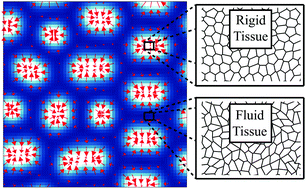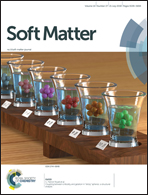Hydrodynamics of shape-driven rigidity transitions in motile tissues†
Abstract
In biological tissues, it is now well-understood that mechanical cues are a powerful mechanism for pattern regulation. While much work has focused on interactions between cells and external substrates, recent experiments suggest that cell polarization and motility might be governed by the internal shear stiffness of nearby tissue, deemed “plithotaxis”. Meanwhile, other work has demonstrated that there is a direct relationship between cell shapes and tissue shear modulus in confluent tissues. Joining these two ideas, we develop a hydrodynamic model that couples cell shape, and therefore tissue stiffness, to cell motility and polarization. Using linear stability analysis and numerical simulations, we find that tissue behavior can be tuned between largely homogeneous states and patterned states such as asters, controlled by a composite “morphotaxis” parameter that encapsulates the nature of the coupling between shape and polarization. The control parameter is in principle experimentally accessible, and depends both on whether a cell tends to move in the direction of lower or higher shear modulus, and whether sinks or sources of polarization tend to fluidize the system.



 Please wait while we load your content...
Please wait while we load your content...